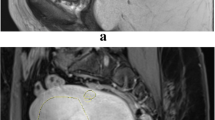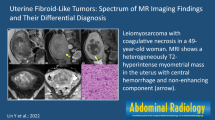Abstract
Purpose
To establish MRI features that help differentiate atypical leiomyomas and leiomyomas with degeneration that show hyperintensity on T2WI from leiomyosarcomas.
Methods and materials
This retrospective study evaluated 41 women who performed MRI before undergoing hysterectomy and had histologically proven atypical leiomyomas, leiomyomas with degeneration or leiomyosarcomas (21 leiomyomas; 20 leiomyosarcomas); only patients with T2 hyperintense myometrial tumors were included. The association between MRI features (contours; free pelvic fluid; intra-tumoral hemorrhagic areas, T2 heterogeneity; T2 dark areas; flow voids; restriction on diffusion-weighted images; signal intensity and heterogeneity after contrast administration; unenhanced areas, localization of unenhanced areas; necrosis; cystic areas) and the histology (leiomyoma vs. leiomyosarcoma) were calculated using Fisher’s exact test. For those features that showed a significant association, a univariate linear regression was performed.
Results
Five MRI features demonstrated a significant correlation with malignant histology: irregular borders (p = 0.03); “T2 dark” areas (p = 0.02); presence of central necrosis (p = 0.01); presence of high signal on b1000 DWI (p < 0.001); ADC value lower than 0.82 × 10−3 mm2/s; hyperenhancement of the tumor relative to the myometrium on post-contrast images (p = 0.02); and type 3 enhancing curve on DCE. Two of these features demonstrated a significant result predicting a malignant histology: lobulated contours and central necrosis [F(3;34) = 8,95; p < 0.001; R2 = 0.506].
Conclusion
The presence of lobulated borders, T2 dark areas, necrosis, hyperintensity relative to the myometrium after contrast administration, central necrosis, presence of high signal on b1000 DWI, ADC value lower than 0.82 × 10−3 mm2/s and type 3 enhancing curve on DCE can help distinguish between leiomyoma and leiomyosarcoma. The association of lobulated borders and central necrosis can help predict a malignant histology.





Similar content being viewed by others
References
Bolan C, Caserta MP (2016) MR imaging of atypical fibroids. Abdom Radiol (NY) 41 (12):2332-2349. https://doi.org/10.1007/s00261-016-0935-0
Ryan GL, Syrop CH, Van Voorhis BJ (2005) Role, epidemiology, and natural history of benign uterine mass lesions. Clin Obstet Gynecol 48 (2):312-324
Rha SE, Byun JY, Jung SE, Lee SL, Cho SM, Hwang SS, Lee HG, Namkoong SE, Lee JM (2003) CT and MRI of uterine sarcomas and their mimickers. AJR Am J Roentgenol 181 (5):1369-1374. https://doi.org/10.2214/ajr.181.5.1811369
Arleo EK, Schwartz PE, Hui P, McCarthy S (2015) Review of Leiomyoma Variants. AJR Am J Roentgenol 205 (4):912-921. https://doi.org/10.2214/ajr.14.13946
Schwartz LB, Zawin M, Carcangiu ML, Lange R, McCarthy S (1998) Does pelvic magnetic resonance imaging differentiate among the histologic subtypes of uterine leiomyomata? Fertil Steril 70 (3):580-587
Owen C, Armstrong AY (2015) Clinical management of leiomyoma. Obstet Gynecol Clin North Am 42 (1):67-85. https://doi.org/10.1016/j.ogc.2014.09.009
Ueda H, Togashi K, Konishi I, Kataoka ML, Koyama T, Fujiwara T, Kobayashi H, Fujii S, Konishi J (1999) Unusual appearances of uterine leiomyomas: MR imaging findings and their histopathologic backgrounds. Radiographics 19 Spec No:S131-145. https://doi.org/10.1148/radiographics.19.suppl_1.g99oc04s131
Cornfeld D, Israel G, Martel M, Weinreb J, Schwartz P, McCarthy S (2010) MRI appearance of mesenchymal tumors of the uterus. Eur J Radiol 74 (1):241-249. https://doi.org/10.1016/j.ejrad.2009.03.005
Tanaka YO, Nishida M, Tsunoda H, Okamoto Y, Yoshikawa H (2004) Smooth muscle tumors of uncertain malignant potential and leiomyosarcomas of the uterus: MR findings. J Magn Reson Imaging 20 (6):998-1007. https://doi.org/10.1002/jmri.20207
. Sato K, Yuasa N, Fujita M, Fukushima Y (2014) Clinical application of diffusion-weighted imaging for preoperative differentiation between uterine leiomyoma and leiomyosarcoma. Am J Obstet Gynecol 210 (4):368 e361-368 e368. https://doi.org/10.1016/j.ajog.2013.12.028
Namimoto T, Yamashita Y, Awai K, Nakaura T, Yanaga Y, Hirai T, Saito T, Katabuchi H (2009) Combined use of T2-weighted and diffusion-weighted 3-T MR imaging for differentiating uterine sarcomas from benign leiomyomas. Eur Radiol 19 (11):2756-2764. https://doi.org/10.1007/s00330-009-1471-x
Tamai K, Koyama T, Saga T, Morisawa N, Fujimoto K, Mikami Y, Togashi K (2008) The utility of diffusion-weighted MR imaging for differentiating uterine sarcomas from benign leiomyomas. Eur Radiol 18 (4):723-730.. https://doi.org/10.1007/s00330-007-0787-7
Lakhman Y, Veeraraghavan H, Chaim J, Feier D, Goldman DA, Moskowitz CS, Nougaret S, Sosa RE, Vargas HA, Soslow RA, Abu-Rustum NR, Hricak H, Sala E (2017) Differentiation of Uterine Leiomyosarcoma from Atypical Leiomyoma: Diagnostic Accuracy of Qualitative MR Imaging Features and Feasibility of Texture Analysis. Eur Radiol 27 (7):2903-2915. https://doi.org/10.1007/s00330-016-4623-9
Thomassin-Naggara I, Dechoux S, Bonneau C, Morel A, Rouzier R, Carette MF, Darai E, Bazot M (2013) How to differentiate benign from malignant myometrial tumours using MR imaging. Eur Radiol 23 (8):2306-2314. https://doi.org/10.1007/s00330-013-2819-9
Sahdev A, Sohaib SA, Jacobs I, Shepherd JH, Oram DH, Reznek RH (2001) MR imaging of uterine sarcomas. AJR Am J Roentgenol 177 (6):1307-1311. https://doi.org/10.2214/ajr.177.6.1771307
Tasaki A, Asatani MO, Umezu H, Kashima K, Enomoto T, Yoshimura N, Aoyama H (2015) Differential diagnosis of uterine smooth muscle tumors using diffusion-weighted imaging: correlations with the apparent diffusion coefficient and cell density. Abdom Imaging 40 (6):1742-1752. https://doi.org/10.1007/s00261-014-0324-5
Rigby AS (2000) Statistical methods in epidemiology. v. Towards an understanding of the kappa coefficient. Disabil Rehabil 22 (8):339-344
Wallach EE, Vlahos NF (2004) Uterine myomas: an overview of development, clinical features, and management. Obstet Gynecol 104 (2):393-406. https://doi.org/10.1097/01.aog.0000136079.62513.39
Stewart EA (2015) Clinical practice. Uterine fibroids. N Engl J Med 372 (17):1646-1655. https://doi.org/10.1056/nejmcp1411029
Pron G (2015) Magnetic Resonance-Guided High-Intensity Focused Ultrasound (MRgHIFU) Treatment of Symptomatic Uterine Fibroids: An Evidence-Based Analysis. Ont Health Technol Assess Ser 15 (4):1-86
Pritts EA, Vanness DJ, Berek JS, Parker W, Feinberg R, Feinberg J, Olive DL (2015) The prevalence of occult leiomyosarcoma at surgery for presumed uterine fibroids: a meta-analysis. Gynecol Surg 12 (3):165-177. https://doi.org/10.1007/s10397-015-0894-4
Pron G (2006) New uterine-preserving therapies raise questions about interdisciplinary management and the role of surgery for symptomatic fibroids. Fertil Steril 85 (1):44-45; discussion 48-50. https://doi.org/10.1016/j.fertnstert.2005.09.014
Wu TI, Yen TC, Lai CH (2011) Clinical presentation and diagnosis of uterine sarcoma, including imaging. Best Pract Res Clin Obstet Gynaecol 25 (6):681-689. https://doi.org/10.1016/j.bpobgyn.2011.07.002
Matsuda M, Ichimura T, Kasai M, Murakami M, Kawamura N, Hayashi T, Sumi T (2014) Preoperative diagnosis of usual leiomyoma, atypical leiomyoma, and leiomyosarcoma. Sarcoma 2014:498682. https://doi.org/10.1155/2014/498682
Santos P, Cunha TM (2015) Uterine sarcomas: clinical presentation and MRI features. Diagn Interv Radiol 21 (1):4-9. https://doi.org/10.5152/dir.2014.14053
Hricak H, Tscholakoff D, Heinrichs L, Fisher MR, Dooms GC, Reinhold C, Jaffe RB (1986) Uterine leiomyomas: correlation of MR, histopathologic findings, and symptoms. Radiology 158 (2):385-391. https://doi.org/10.1148/radiology.158.2.3753623
Murase E, Siegelman ES, Outwater EK, Perez-Jaffe LA, Tureck RW (1999) Uterine leiomyomas: histopathologic features, MR imaging findings, differential diagnosis, and treatment. Radiographics 19 (5):1179-1197. https://doi.org/10.1148/radiographics.19.5.g99se131179
Goto A, Takeuchi S, Sugimura K, Maruo T (2002) Usefulness of Gd-DTPA contrast-enhanced dynamic MRI and serum determination of LDH and its isozymes in the differential diagnosis of leiomyosarcoma from degenerated leiomyoma of the uterus. Int J Gynecol Cancer 12 (4):354-361
Author information
Authors and Affiliations
Corresponding author
Additional information
Publisher's Note
Springer Nature remains neutral with regard to jurisdictional claims in published maps and institutional affiliations.
Rights and permissions
About this article
Cite this article
Rio, G., Lima, M., Gil, R. et al. T2 hyperintense myometrial tumors: can MRI features differentiate leiomyomas from leiomyosarcomas?. Abdom Radiol 44, 3388–3397 (2019). https://doi.org/10.1007/s00261-019-02097-x
Published:
Issue Date:
DOI: https://doi.org/10.1007/s00261-019-02097-x




